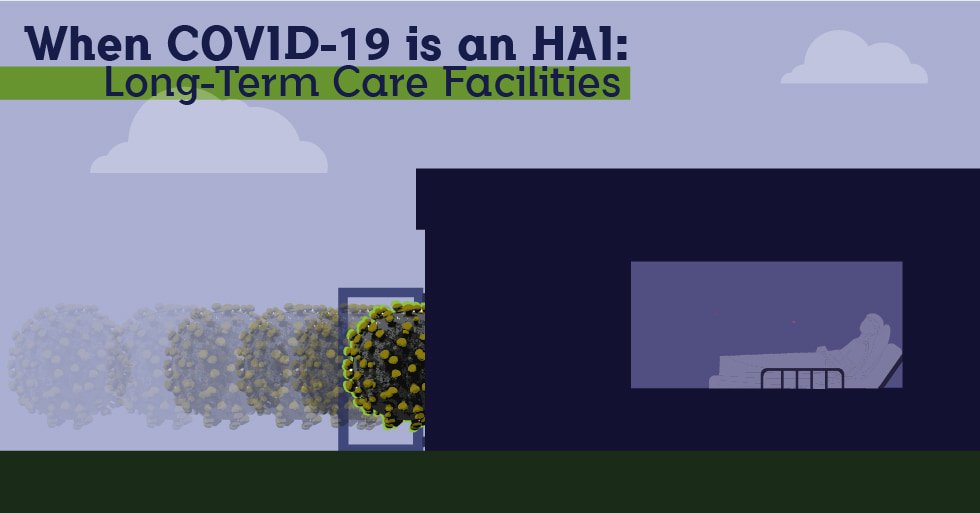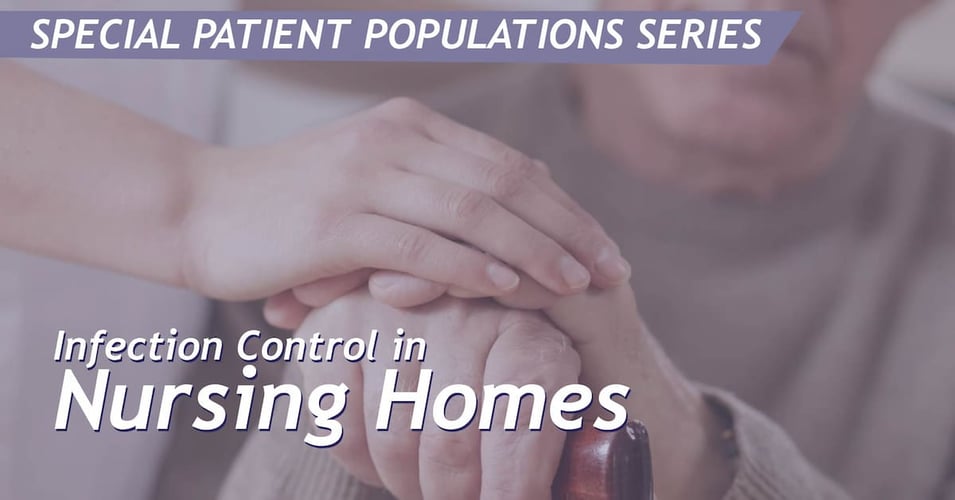When COVID-19 is an HAI: Long-Term Residential Facilities

 Recent reports brought a stunning number to light: 42% of deaths due to COVID-19 have taken place in long-term residential facilities. Just .61% of our population lives in a residential facility (nursing home or assisted living facility), making this disproportionate death rate truly shocking. While deaths in these facilities are high in part because of the health of the residents, we cannot overlook the fact that the virus spread within the facility, affecting both patients and staff. This means that for many of these cases, COVID-19 was a healthcare-associated infection, or HAI. In today's post, we'll look at what made it so easy for the virus to spread so fatally within long-term facilities.
Recent reports brought a stunning number to light: 42% of deaths due to COVID-19 have taken place in long-term residential facilities. Just .61% of our population lives in a residential facility (nursing home or assisted living facility), making this disproportionate death rate truly shocking. While deaths in these facilities are high in part because of the health of the residents, we cannot overlook the fact that the virus spread within the facility, affecting both patients and staff. This means that for many of these cases, COVID-19 was a healthcare-associated infection, or HAI. In today's post, we'll look at what made it so easy for the virus to spread so fatally within long-term facilities.
When the first cases of COVID-19 were detected in the US, they immediately hit nursing home facilities hard. In Kirkland, Washington, the first major outbreak infected almost 85% of the residents, claiming the lives of over a third. Other nursing homes were soon affected - over 7,700 facilities with an estimated total of 153,000 cases, 11% of the total cases in the nation (as of May 11). The fatality rate is consistent across the board, with approximately 33% of infected nursing home and assisted living facilities residents passing away as a result of COVID-19. These results are shocking as is, but when you realize that they are incomplete because so many states aren't even tracking infections, and that these statistics do not include intermediate and transitional care faciliities, these statistics are staggering.
How did this happen? How did residents of nursing homes, who don't travel much (and often don't leave at all) become the victims of such widespread outbreaks? The virus entered through the front door, and then spread like wildfire.
Long-term healthcare facilities come in many forms, from 24-hour medical care to independent living. But these facilities share features that make them particularly vulnerable to outbreaks.
#1 Vulnerable patients who are elderly and have underlying medical conditions. While not all residents have chronic conditions, just being of advanced age brings its own dangers. Immune system responses are not as strong as we get older, and symptoms can look different, and therefore go unnoticed.
#2 Shared living spaces that are not cleaned as thoroughly or as often as patient areas. Grab bars, handles, armrests, remote controls, and even venting machine buttons can go days - or more - without disinfection. These surfaces become pathogen reservoirs. Additionally, staff move from room to room, making them - their hands, their equipment - shared spaces as well.
#3 Visitors and outside personnel who may not follow infection prevention protocols. Family, friends, clergy, volunteers, school choirs - all these loving visitors bring pathogens in from the outside, right through the front door These individuals may not follow handwashing guidelines, or feel comfortable wearing PPE.
#4 Very little infection control surveillance or regulation. Unfortunately, the pressures to make nursing home facilities available to meet the demand of an ever-growing aging population has led to a situation where long-term care facilities are exempt from many of the infection control and prevention regulations that hospitals must meet. They do not have to track or report infections, have emergency plans in place, engage in infection control education, or many of the other protocols that are in place to keep patients safe. (Not yet.)
So what happened with COVID-19? You take a vulnerable, self-enclosed population (#1) sharing spaces that are not disinfected (#2). You add one infected outsider - visitor, staff, worker, volunteer - who enters the facility and interacts with insiders and surfaces (#3), and a regulatory environment that means that not all facilities adhere to infection control guidelines (#4) and you have everything you need for a virus to gain a foothold and devastate the population. And we'll add a 5th attribute that could spell disaster for nursing homes going into the future: They are not prioritized for testing results. This means they can run the tests, but they have to wait 7-10 days for the results.
Should this have happened? We all know that this novel coronavirus has attributes that made containment extremely difficult, not the least of which is a long latent period when infected individuals show no symptoms but are still contagious. But the scale of the devastation, many experts agree, could have been mitigated if nursing homes, including Veteran's facilities, were more strictly regulated. This regulation is expensive, both for the facility and the regulatory body, and these facilities are in such high demand that closing them down would present its own list of health and societal impacts. And nursing homes are notoriously under-funded, especially those serving low socioeconomic areas. While these obstacles seem insurmountable, they are issues that we must confront today. Nursing homes and other long-term care facilities are here to stay. We must do better about protecting our loved ones who live and work in them. In a future post, we will look at some of the changes that COVID-19 has pushed nursing facilities to make, as well as changer to oversight that may bring about needed improvements.
![EOScu Logo - Dark - Outlined [07182023]-01](https://blog.eoscu.com/hubfs/Eoscu_June2024/Images/EOScu%20Logo%20-%20Dark%20-%20Outlined%20%5B07182023%5D-01.svg)




